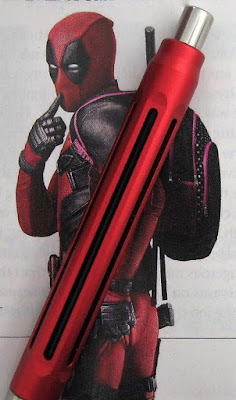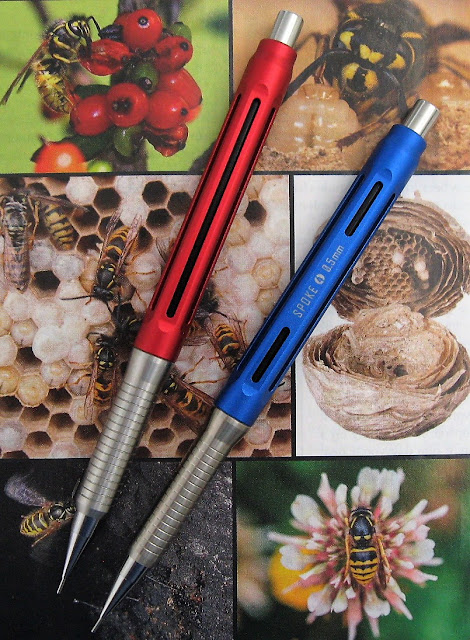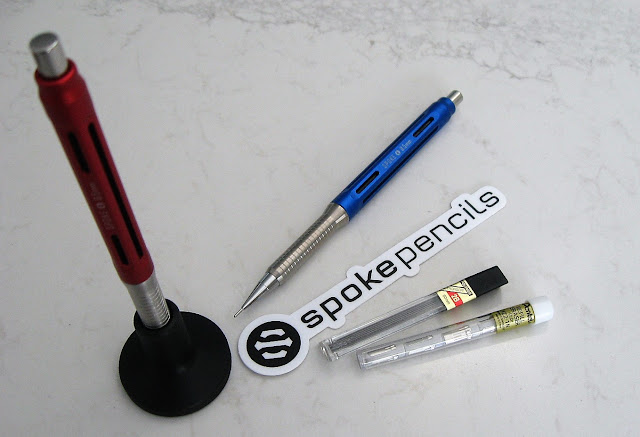Spoke Design Mechanical Pencils
I first became aware of Spoke Design back in July 2012 when they launched a Kickstarter campaign for a mechanical pencil. The campaign was a success with 318 backers funding US $16,782. That was the original Spoke mechanical pencil, Spoke 1, and now they are onto the Spoke 4 mechanical pencil. I have recently been in touch with Brian from Spoke and thought it would be interesting to do an interview with him. Happily, Brian agreed.****
1 - So, Brian, tell us a little about yourself and Spoke Design.
I’m a mechanical design engineer and I live in Charlotte, North Carolina USA. I have spent my whole career in new product development. The majority of my career has been working for corporations in various industries (telcom, barcode equipment, security devices). The bulk of my experience is actually in plastic part and product design, but I am a hobby woodworker and a very hobby machinist. I have been working full-time on my own for over a year now. The Spoke brand is a part of the product design and development company I run with my brother Dan… aptly named Conti-Bros, Inc. It’s a small enterprise… it’s just us two and Dan is part-time.
2 - I imagine as a mechanical design engineer you have used a pencil or two throughout your career?
Absolutely… I sketch out ideas constantly, so pencils are my preference for that. I’ve always been a user and fan of the Pentel Sharp pencils… probably because they have been somewhat of a standard throughout the years. I’d say I use .5mm most often… and I prefer 2B lead.
3 - Let’s quickly go through some history. Spoke 1…. Was it a case of one day you were just sitting there and thought “I want to design and make a good mechanical pencil and sell it to some people.” So you did? Perhaps though there was a little bit more to it than that, a long evolutionary process?
Years ago I was browsing online and I ran across a news article about how this new website called Kickstarter had just had their first million dollar project (a machined iphone stand I think). I had never heard of Kickstarter or crowdfunding… when I looked up the site I became fascinated with how it could be used to find, test, or create a market for new unique products. I had to give it a try. My first two submissions were actually rejected by Kickstarter… they were designs for ‘active foot rests’. As I spent so much time at my desk, I had made prototypes of these for myself to allow some ‘fidgeting’ with my feet. Back then, Kickstarter didn’t allow ‘exercise products’ so they rejected my submissions (they have since changed their policy and others have successfully funded several similar products to what I had originally submitted). Undeterred, I noticed a few machined pens really becoming popular on Kickstarter… so I decided I could try to see if there was a similar interest for a machined body mechanical pencil… my preferred sketching instrument.
Many of the pens on Kickstarter are simply ‘minimal’ cylinders… largely indistinguishable from each other. My goal was to make something very distinct and immediately recognizable by its design… after lots of sketching and prototyping… I settled on long slot features to be the signature design element. The Spoke name seemed a natural description of these features. The project was a moderate success on Kickstarter (after all pens are a much bigger market versus mechanical pencils), and that’s how Spoke got started.
4 - Spoke 1 was obviously a success by whatever measures you personally use because you have carried on and now there is Spoke 4. What’s the one big thing you learned from the Spoke 1 campaign? By the way, what do you call the original Spoke mechanical pencil now there’s more than one?
Spoke 1, Spoke Original – I’ve called it both. From the outset, I had planned to do versions of the pencil… the initial pencil is designated by a machined ‘dot’ on its end… so I also refer to it as Spoke Pencil single dot.
There were three big takeaways from Spoke 1 (single dot)…
First, while I can make various types of prototypes, for production quantities, I had to develop a capable supply chain for my intricately machined and anodized parts. It’s fun creating relationships with machine shops and working together to produce cool parts. It’s always exciting and fulfilling to take something from sketch to physical product, but volume manufacturing has its own set of challenges and learnings as well.
Secondly, the initial project provided an introduction to the Kickstarter system. Crowdfunding is a unique process with lots of things to learn. Since the original Spoke Pencil we’ve used Kickstarter to fund several other products (most notably a brand of magnetic products under the brand of Strong Like Bull Magnets.
The third thing I’ve learned is that selling products online is quite difficult. As a design engineer, I had little experience with e-commerce, marketing, website creation, etc. I’ve since learned quite a bit through the years… and continue to work on this area.
5 - With perfect hindsight, what would you have done differently?
While I’ve learned a lot along the way and have definitely had some missteps… those things were part of the journey so to speak. Overall I’m happy with the path I took.
6 - The wood turning folk have always had pen and pencil mechanisms readily available for their use. One of the intriguing features of Spoke 1 was your use of Pentel P205 mechanisms. I’m imagining you buying a few hundred Pentel’s from a local store, ripping their mechanisms out (sacrilege!) and assembling them into your Spoke bodies. Is that what actually happened? Where are you sourcing your pencil mechanisms from now?
I buy the standard pencils wholesale from a distributor. The great thing about the Pentel P200 series is that they are readily disassemble-able. This makes it easy for me to utilize the mechanism and also easy for customers to get ‘replacement parts’ if ever needed.
7 - Tell us about Spoke 1, 2, 3 and 4. What’s different about them? What did you learn from each and think you would like to try on the next variant? Has feedback from users influenced you much?
 |
The Spoke Design series of mechanical pencils. Top to bottom, 4 to 1.
Photo courtesy of Brian
|
Spoke Pencil (single dot)… the original. A one piece pencil body utilizing the P200 series mechanism. The body is machined from aluminium, has a swooping profile with hexagonal cross section and of course the six signature slots. There’s quite a bit of machining going on there. It was funded on Kickstarter and now retired from sale, although I do have a few reworked pencils I sell occasionally.
Spoke Pencil 2 (double dot). Spoke 2 was a follow up design that was more a refinement than new design. The main change was a slightly smaller profile and a bit narrower slots. It was released on my website and not a Kickstarter project. Spoke 2 is now retired from sale, although again, I do have a few reworked pencils I put for sale occasionally.
Then there was Spoke Inverse. The inverse was a shift to a more simple cylindrical design, with the main feature being an inverted taper in the grip area. Inverse was a smaller pencil altogether, using the Pentel P225 mechanism (since discontinued). It was released on my website only. Inverse is retired from sale, although I do have a few reworked pencils I sell occasionally.
Spoke Model 3 (triple dot). The model 3 was a big departure in design and material. I decided to go with Titanium. Design-wise it has a stepped profile with circular cross sections, bevelled edge slots, and a heavily grooved grip. The model 3 proved to be quite difficult to machine… and ultimately only 100 were made. Model 3 was released on my website… and is now sold out.
Spoke 4. By this point I had received a good amount of feedback and requests from customers for various materials, colors, and grip sizes. There’s no one perfect pencil configuration to satisfy everyone, but I thought it would be unique to offer a degree of customization to try and address common requests. The solution was a two piece body design in order to provide a range of material, color, and size options to customers. This level of customization has proven to be popular. The model 4 is an interesting pencil in that depending on configuration it can vary significantly in how it looks and feels… many customers order 2 or 3 and mix up their order configurations a good bit. I’ve decided to make the model 4 a ‘standard’ pencil with no plans to retire it any time soon. In fact, I plan to add some additional colors.
8 - As you have mentioned, the Spoke 4 mechanical pencil is a pick ‘n’ mix of 5 different grips, each in 2 diameters, and 5 different barrels, so that’s 50 combinations. Which combination if your personal favourite? Is there any clear preference from customers for grip diameter, grip material or barrel colour?
I have several pencils on my desk, so I do mix up what I use quite a bit. Overall I probably favour the smaller diameter 8.3mm grip in Titanium with a blue barrel. The titanium moves the balance point closer to the tip while not adding too much overall weight, and the blue provides a nice contrast to the spoke grooves. As for customers, the classic look of Titanium with a black anodized barrel is most popular. Orders are generally split pretty evenly between the 8.3mm and 9.2mm grip diameters. While the dimensional difference seems quite small… the result is a big difference in feel.
9 - You have offered your various Spoke pencils in 0.5, 0.7 and 0.9mm lead sizes. What has been the most popular?
The .5mm is the most popular… I’d say half of all orders are for .5mm with the remainder spilt pretty evenly between .7mm and .9mm.
10 - You have also branched out into some other stationery related items. I guess anything on your desk is fair game?
I have quite a diverse background in the types of products I have developed. Under Spoke, I’ve done a machined ring holder and more recently a machined note holder… both on Kickstarter. While I do enjoy the challenge of working on a variety of product categories, I really enjoy working on writing instruments… and expect to keep releasing new Spoke designs going forward.
11 - Okay, well thanks for telling us this Brian. All the best for the future… so Spoke 5 is already in your thoughts?
Yes, Spoke 5 is coming! I’m at the prototype stage and hopefully it’ll be ready to go in the next month or so! However, the model 5 is more exploration of the spoke design… not a model 4 replacement.
****
I will leave you another nice photo supplied by Brian.
 |
| L to R - The history of Spoke pencils to date |






















